How to use Deep Research for GTM
You could save 10+ hours per week with this underused AI function
👋 Hi, it’s Kyle Poyar and welcome to Growth Unhinged, my weekly newsletter exploring the hidden playbooks behind the fastest-growing startups.
I’m totally hooked on Deep Research mode within ChatGPT and Perplexity. I can’t tell you how much time it has saved me when compiling information for this newsletter or, honestly, for any research-intensive GTM project. It’s one of the most powerful, yet underused AI functions that exists today. Let’s change that.
For help I turned to Torsten Walbaum who’s built and led strategy and analytics teams at companies like Uber, Meta and Rippling. Torsten now writes the fantastic The Operator's Handbook, which I cannot recommend highly enough. True to form, Torsten shares an immensely practical guide for turning Deep Research into your own personal McKinsey-caliber analyst.
Deep Research is the first AI feature that truly blew my mind.
It’s the first time that AI is able to solve complex non-engineering tasks end-to-end, from developing a plan to gathering relevant context and then producing a high-quality deliverable. I’m usually hesitant to make bold claims with regards to AI, but Deep Research has literally condensed tasks that took me 10+ hours into minutes (once I figured out how to use it correctly).
Despite this, there seem to be fewer Deep Research power users than I expected, and I think it has to do with the name. “Research” makes it sound like it’s mostly a tool for academics and investors, but that only scratches the surface; in reality, it’s a game changer for any task that involves reviewing lots of information and distilling practical insights from it.
And, as it turns out, that’s almost any project in GTM.
That’s the first reason I teamed up with Kyle to write this article: By walking through real-world GTM use cases, I want to show what the tool is capable of and inspire more people to use it creatively.
The other reason is that despite its enormous potential, Deep Research isn’t perfect, and you need to provide a lot of handholding to the AI if you want top-tier results. In contrast to many other AI use cases, how you write the prompt actually still matters a lot here, and the context you provide can make or break the result.
In the rest of this post, we’ll cover:
Actionable tips on how to get the best outputs from Deep Research
What an effective Deep Research prompt looks like
Which tool (ChatGPT, Gemini, Claude, Perplexity, Grok) is best for what
Five practical GTM use cases with prompt examples you can try right now (plus more ideas for inspiration)
How to get the best results from Deep Research
Regardless of which AI tool you use (more on that below), there are a few key limitations you should be aware of.
Don’t worry, though: All of them can be addressed, and we’ll go through the exact workflows and prompting techniques that will get you the best results.
1. Point the research agent to high-quality sources
The quality of the output you get from Deep Research is heavily dependent on the sources the agents use. Unfortunately, they often show bad judgment here: They’ll treat social media opinions as facts, over-index on individual sources, or use outdated data. It can be extremely frustrating to notice this after the report is done because you’ll have to re-do the whole thing and lose 15 minutes plus valuable research credits in the process.
There are two simple ways to fix this, though:
Option 1: Specify in the prompt what kind of sources to prioritize (e.g. primary sources like government data over secondary ones like news articles)
Option 2: Use an AI model like GPT-5 or Claude Opus to create a list of specific high-quality sources and then feed that into Deep Research (you’ll see this in action in example #5 below)
In addition, if you want more transparency, you can also ask the research agent to:
Always provide in-text citations for any claim it makes
Add a table to the report that lists all sources and shows which source was used for what, what type of source it is, what year the data is from, etc.
Outline where different sources disagree (esp. when it comes to data) and what the reason might be (e.g. differences in methodology)
This only adds one minute to your workflow, but will save you lots of headaches down the road.
2. Provide context to get customized insights
Getting an in-depth overview of a topic at the click of a button is already kind of neat; but it’s not actually that useful. To really get value out of it, you need something that’s tailored to your particular situation.
Unfortunately, most Deep Research tools are not in the habit of asking for the context they need. So if you don’t proactively provide relevant information, they’ll either make assumptions or keep things generic.
To avoid this, you’ll need to provide all the context that a human team member would need as well. What exactly that is depends on the situation, but here are a few common things you’ll likely want to touch on:
💼 Where you work and how your company operates
This is especially important if you want the AI to come up with concrete recommendations for what to do and/or tactical guidance for how to implement the suggestions.
If your company has a large online presence, it’s often enough to just mention where you work; but if you’re at a small startup, it’s better to briefly outline what the company does, how big it is, plus anything else relevant for the specific task (e.g. how your GTM motion works etc.).
🎯 What exactly you’re trying to achieve
Often, when I see people use Deep Research, they give the AI a task (e.g. “Pull together a report comparing these tools”) without sharing the motivation and ultimate goal (e.g. “We’re trying to get better visibility into campaign performance for planning and budget allocation”).
The more transparent you are about your goal and where the AI fits in, the more impactful the result will be. And if the request is part of a larger project, make sure you share any work that has been done up to that point.
🚧 [If applicable] What constraints you’re facing
If there are hard constraints that will rule out certain options, share this to get a more targeted report:
How much budget and headcount do you have for implementing this project?
Are there any deadlines you’re working towards?
Anything leadership or legal won’t approve based on past experience?
Pro tip: If you don’t want to provide context every time you prompt Deep Research, create a Project. That way, you only need to upload the initial context once, and every research report adds to the joint knowledge between you and the AI.
The above is a good start, but I’ve noticed that it can be pretty difficult to brainstorm exactly what you should be sharing, especially when you’re trying to move fast.
To make things easier, I’ve started asking AI for its take (GPT-5 and Claude Opus both do a great job):
I'm planning to generate a Deep Research report on [X] in order to [Y]. What context should I provide so that I get a customized, actionable report? Pretend you have no context from any prior conversations.Lastly, if you want to be sure you didn’t miss anything, ask the Deep Research agent directly to get additional context from you:
3. Ask for a research plan before getting started
The biggest advantage of Gemini Deep Research is that it always shares a plan before it gets going; that way, you can make adjustments in advance instead of waiting 20 minutes only to find that you disagree with the methodology or the report focuses on the wrong thing.
None of the other tools do that; instead, you need to explicitly ask for the research plan in your prompt:
Note: Make sure you repeat the request if you’re answering any questions after your initial prompt. Otherwise, the tools sometimes forget about it.
A few questions to ask yourself as you’re reviewing the research plan:
Does it cover everything you’re interested in? Would you like any additional outputs (e.g. templates, code snippets, etc.)?
Do you agree with the methodology and focus areas (e.g. how the agent plans to evaluate different options)?
Does the AI seem to be making any assumptions, or do any parts seem generic? If so, you need to provide additional context.
4. Specify an easy-to-digest report format
The default reports you get back are often hard to read, especially if you want to skim them for the most important insights.
It’s easy to change that with the right prompt, though. Just ask to:
Include a summary at the beginning of the document and every individual section
Start with the key insights or recommendations before going into details
Use overview tables or visuals instead of text blocks where appropriate
How to write a good Deep Research prompt
Putting all of the tips from above together and adding a few optional ones, this is what an effective Deep Research prompt looks like.
Just copy this and plug in your own information (the comments marked with “#” are there to explain each section and should not be included in the prompt):
# Goal: State 1) what you’re ultimately trying to accomplish, and 2) what exactly you want the AI to do. Example:
<goal> We want to build an account score to inform account allocation to SDRs and prioritize which accounts we reach out to. The desired model will assign 1) a firmographic fit score (i.e. "Is this company generally a good fit?”) as well as 2) an intent score (i.e. "Is this account currently in the market / likely to buy?") to each account. </goal>
# Context: Include all relevant context for the request that’s not already in your Project. Example:
<context> We’re currently focused on the US market only. Our GTM and data stack consists of Salesforce, Marketo, Outreach, dbt and Snowflake; we’re open to buying intent data sources. Explainability of the model and scores is key </context>
# [Optional] Content: Specify what you want included in the final output, e.g. comparisons, SQL code snippets, specs for Salesforce custom objects etc.. Example:
<content> Please cover, at a minimum: 1) A detailed “build vs. buy” analysis and recommendation, 2) An overview of the various approaches for building this in-house, 3) How to operationalize the account score between Marketing and Sales, 4) How we can provide visibility for sales reps into how the scores were derived </content>
# [Optional] Style: Define the format of the report. This is best included in the Project custom instructions as it can usually be the same for each research task. Example:
<style> Follow the Pyramid Principle: State key takeaways or recommendations first, then add supporting arguments and data where appropriate. When you give a recommendation, make sure you explain exactly how you arrived at it. Use bullet points, overview tables and other formatting to make the report easy to parse. </style>
# [Optional] Sources: Specify which sources the AI should prioritize and/or how it should document them. Example:
<sources> For tool comparisons, focus on assessments from leading industry blogs or practitioners instead of claims from the companies themselves </sources>
# [Optional] Instructions: Provide misc. instructions (e.g. specific methodology or steps you want the AI to follow). Example:
<instructions> Please ask for any additional context you need before you proceed </instructions>Note that most sections are marked as optional; you’ll see in the examples below that I pick the ones that I find most relevant for each research task, and I recommend you do the same. There’s no need to overengineer more straightforward requests.
How to choose the right Deep Research tool for your use case
TL;DR: Overall, ChatGPT is the best general-purpose Deep Research tool, especially with the recent release of GPT-5 (no more model switching) and Agent Mode (ability to properly interact with websites).
It has two key strengths:
In contrast to the other tools, it always asks for context
It provides, by far, the most in-depth reports and consistently shows good judgment
The first point is only a minor advantage since you can prompt the other tools to do the same. However, it’s impossible to get the other tools to produce anything close to ChatGPT’s depth and rigor, regardless of how much you optimize your prompt.
That means if you need extremely detailed information or guidance, ChatGPT is the obvious choice. If you don’t need a 10,000 word deep dive, though, the other tools are attractive candidates. For example:
Gemini often does almost as well as ChatGPT and has more generous usage limits, so if you run out of ChatGPT credits, it’s a good fallback option
Perplexity is a good choice if you want to focus the research on particular websites or social forums as it has 1) more granular source controls and 2) follows instructions in this regard better
Claude, Perplexity and Grok all create sleek, easy-to-read reports with 1k - 2k words that are a great entry point if you’re starting to dive into a topic
Because of this, as we’re going through the practical use cases below, I’ll highlight which tool is the best fit in each case.
Practical GTM use cases for Deep Research
Use case #1: Step-by-step guide for large in-house projects
👑 Best tool: ChatGPT Deep Research; 🥈 Runner-up: Gemini Deep Research
“We should start personalizing our outbound emails at scale. Everyone else is doing it!”
Anyone who works in GTM has been in this situation: One day, while you’re happily executing inside your comfort zone, an executive comes to you with a request they want you to prioritize ASAP — but that you have zero experience with.
Whether it’s new AI use cases or table stakes stuff like lead scoring and attribution, no startup has an expert on every topic. So sooner or later, you’ll have to tackle a large project that you have no idea how to approach.
Deep Research is an amazing resource to get you up-to-speed in less than one hour. You won’t become a certified expert this quickly, but you’ll know enough to develop a high-level plan for the project and figure out which areas you need to dive deeper on (or get help with).
Let’s look at a practical example. Imagine you want to build (or re-build) marketing attribution. You have a general idea of what you want to use the attribution for, but no idea how to implement it.
This is what an effective Deep Research prompt for this problem would look like:
<goal> Please put together an in-depth, tactical guide on how to build out marketing attribution in-house for a startup. As a first step, we want a simple attribution model that considers touchpoints from the relevant programs (Email, LinkedIn etc.) and assigns a single source to each created opportunity. </goal>
<context> We’re a B2B SaaS startup selling meeting transcription software. We’re mostly targeting SMBs and are currently at $10M ARR, growing 100% YoY. We’re mostly marketing-led with most leads coming via LinkedIn Ads and programmatic email. We’re using Salesforce, Marketo, dbt, Snowflake. </context
<audience> Assume working knowledge with relevant tools and systems, but zero prior experience with marketing attribution </audience>
<structure> Provide an overview of the key decisions that need to be made and the major work streams. For each body of work, provide an overview of different relevant approaches we could choose from, and then provide a detailed step-by-step guide for your recommended one </structure>
<style> Follow the Pyramid Principle: State key takeaways or recommendations first, then add supporting arguments and data where appropriate. Use bullet points, overview tables and other formatting to make the report easy to parse. </style>☝️ Note: The most important thing here is to provide visibility into your company’s processes and tech stack so that you get a customized playbook.
And this is what you’d get back: An end-to-end attribution guide covering different methodologies, implementation approaches, and step-by-step instructions on how to actually do this (including recommendations for UTM tagging conventions, mock SQL code for dbt models etc.):
Of course, this is just an example; you can get a detailed guide for any GTM topic. Here are some more examples for inspiration:
Building out a content motion from scratch
Migrating from one tool to another (e.g. HubSpot to Marketo)
Structuring a GTM planning process that minimizes friction between Marketing & Sales
Coming up with the right compensation scheme for sales reps
Use case #2: Researching competitors’ ads strategies
👑 Best tool: GPT-5 Agent Mode; 🥈 Runner-up: Perplexity
In the examples above, the goal is to understand one topic holistically by having AI review a lot of different sources and synthesize a best-practice approach. However, sometimes you want to do the opposite and go really deep on one specific data source.
For example, you might be trying to understand how your competitors are growing so successfully through paid ads on LinkedIn (or Google) when you’re struggling to make the economics work.
The good news: You can see all ads that competitors ran, including private message ads, in an ad library (LinkedIn / Google / Meta). And the even better news: Instead of sifting through all of this information manually for days, you can just let AI do the heavy lifting.
The standard research modes of ChatGPT, Claude, and Grok aren’t a great fit for this since it’s next to impossible to get them to do an exhaustive search on a single website. Perplexity does an acceptable job, but the real solution is to turn on Agent Mode in ChatGPT.
It’s advertised as the bridge between research and action, and that’s exactly what it is. You can just tell it to open up the ad library, look at 50 - 100 ads, and write up a detailed report. When prompted correctly, it’s essentially Deep Research with additional skills: It can log into accounts, click on toggles and filters, take screenshots etc.
This is what an effective prompt would look like:
<goal> I'm trying to understand how [Company] uses LinkedIn ads to grow. Please leverage the LinkedIn Ads library (https://www.linkedin.com/ad-library/) to put together a comprehensive report on their positioning, messaging and tactics. </goal>
<context> The detail page for every ad will have a lot of relevant information to consider. For example, it shows what type of ad it is, from when to when it was active, how many impressions it got across regions etc. </context>
<content> Please cover at a minimum the following:
- What ad formats (e.g. message ads vs. single image) and types (e.g. customer case studies, CEO thought leadership etc.) they're running
- Which buyer personas they seem to be targeting
- How they position themselves and core messages to their audiences
- What their calls-to-action look like
- What incentives they offer (e.g. money or gifts to take demos)
Please make sure to include concrete examples for any claim you make (i.e. link to specific ads inline). Please link to at least 20 concrete ad examples (the URL will look like "https://www.linkedin.com/ad-library/detail/[ad_id]") </content>
<instructions> Please review 50+ ads and create a detailed report of 3,000 words or more summarizing your findings </instructions>Note: If you want the insights to be tailored to your company, then upload context about your business or expand the <context> section in the prompt above.
Using this exact prompt (and AI startup ElevenLabs as an example), this is what I got back:
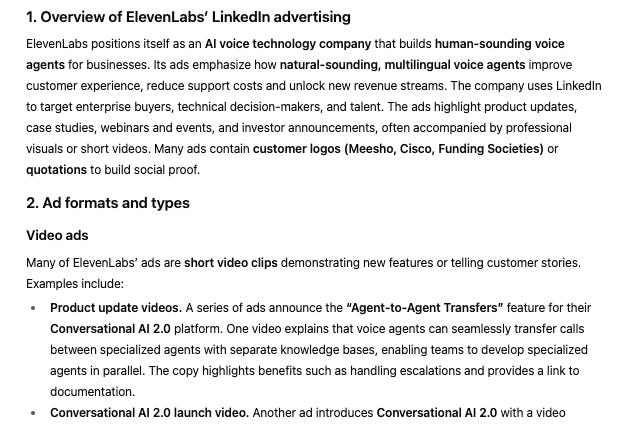
Pretty solid, I’d say. Especially cool: In addition to linking to specific ad examples, the agent also took screenshots, which is a capability that opens up a lot of other use cases.
Use case #3: Conducting an audit of your homepage or landing pages
👑 Best tool: ChatGPT Agent Mode; 🥈 Runner-up: Gemini Deep Research
If you want to overhaul your homepage, you have to:
Research best practices (e.g. here on Growth Unhinged 🙂)
Review competitors’ websites to see what they are doing
Go through your own website in detail to check where you have room for improvement
Mock up planned changes and draft new copy
Deep Research can massively speed this up by providing an assessment that will get you ~80% there; you’ll still need to refine things yourself, but you can skip most of the grunt work.
Here’s a prompt structure that has worked well for me (using Linear’s pricing page as an example):
<goal> Please put together an in-depth analysis of Linear's pricing page (http://linear.app/pricing), critiquing its effectiveness and highlighting where 1) it adheres to industry best practices, 2) it stands out via innovative ideas and 3) where it falls short. </goal>
<structure & content> After a general review of the page, please provide detailed suggestions for improvements, pointing out exactly what should be improved and how, and give examples of other companies doing this better. Rank the improvement ideas by expected impact and implementation effort. If you're suggesting new elements to be added or existing ones to be re-designed, please provide mockups and detailed copy examples we can use as a starting point (in line with the existing tone of the Linear homepage) </structure & content>
<instructions> Please combine insights derived directly from other SaaS companies' pricing pages with best practices discussed in leading industry blogs. Aim for ~3,000 words for the report </instructions>10 minutes later, I got a ~7,600 word analysis full of actionable suggestions.
It provides a detailed teardown of the pricing page and correctly identifies a number of things that could be improved with limited effort; for example:
Highlighting savings from the annual plan
Adding descriptions of who each plan is a good fit for
Highlighting a recommended / most popular plan
Adding more / better tooltips and an FAQ section
However, it also shows well the current limitations of Deep Research. ChatGPT (similar to other tools I’ve used) was unable to use the annual / monthly pricing toggle and (wrongly) assumed there’s no monthly option. Similarly, it couldn’t “see” the rotating row of logos.
In my view, this is not a big deal since it only takes a few seconds to confirm whether the claims are accurate and you can just ignore inaccurate suggestions. But if this bothers you, you can use Agent Mode instead where the AI actually interacts with the website and takes screenshots, avoiding these types of wrong conclusions. You’ll just have to wait longer for the report.
Use case #4: Analyzing competitors’ product features
👑 Best tool: ChatGPT Deep Research; 🥈 Runner-up: Gemini Deep Research
Customer comparison pages are an amazing resource to convince high-intent buyers that are deciding between different solutions, and they’re becoming even more important with the rise of Answer Engine Optimization (AEO).
But if you’re trying to create these, or run ads focused on superior features your product has compared to competitors, you’ll need to do a lot of research.
Reviewing competitors’ websites, reading documentation and help articles, watching YouTube tutorials, etc. can easily take multiple days, and there isn’t really a way around it if you want to make accurate claims.
Luckily, Deep Research is pretty good at this. If you’re starting from scratch, I recommend kicking off with a high-level prompt to Claude, Perplexity or Grok; they don’t go as deep as ChatGPT or Gemini, but you’ll quickly get a well-formatted summary of the most important themes.
<goal> I work at [Company] and want to understand how our product compares to [Competitor]. Please compile a detailed report comparing features of both platforms and highlighting any gaps on either side. </goal>
<sources> Please prioritize primary sources that contain facts; i.e. don't rely on anybody's interpretation of what the products can do, but rather focus on official documentation, feature announcements etc. Use in-text citations for ANY claims you make </sources>
<instructions> Make sure to check that any product gaps you’re highlighting still exist; e.g. if you find a report from a year ago that claims a feature is missing, conduct a search to see if it was addressed in the meantime </instructions>This should give you a basic idea of where your product might have a potential edge, and you can then give a more refined prompt to ChatGPT where you ask for detailed information on specific capabilities.
Then, once you have your deep dive report, ask for any additional clarifications you need or challenge claims that contradict what you’ve seen until you feel fully confident in the comparison.
Finally, you can also ask to get suggestions for how to turn these insights into a compete page:
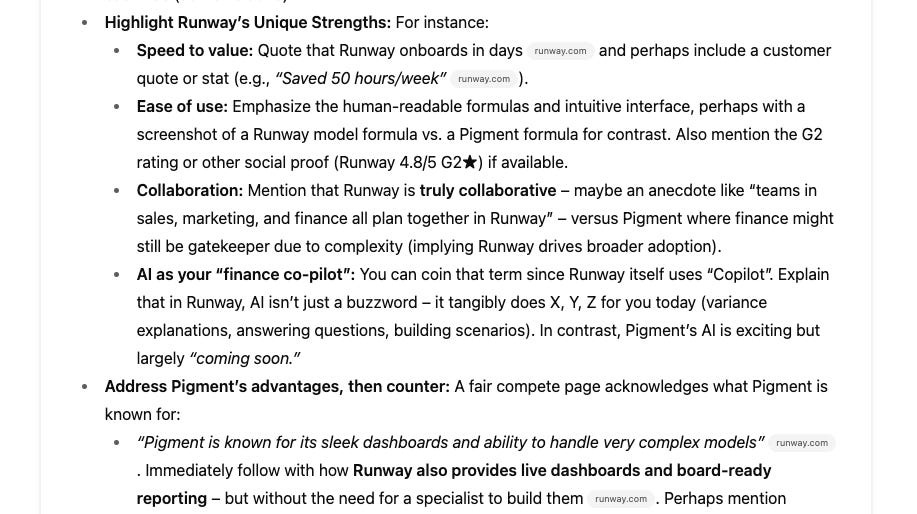
⚠️ The main things to watch out for:
Products change frequently, so you really want to make sure that any claims are based on the most recent information. This means:
Instructing the research agent to prioritize the most recent sources and focus on information from the last 6 months (like we did in the example above)
Doing a quick Google search to confirm that the most important claims are still accurate
No matter how well you write the initial prompt, the AI will often cite vague marketing claims like “superior AI capabilities”. When this happens, I recommend pushing back and demanding detailed examples; the second version is often much better
Use case #5: Market assessment for international expansion
👑 Best tool: GPT-5 Thinking / Claude Opus for framework & data sources; ChatGPT Deep Research for final report
Sooner or later, every startup will have to deal with internationalization. But which countries should you expand into, and in what order?
For this, I’m recommending a two-step approach:
First, work with the AI model of your choice (e.g. GPT-5 or Claude Opus) on developing your expansion framework and finding high-quality data sources
Then, ask ChatGPT Deep Research to create a detailed report ranking potential countries across the dimensions you came up with
Generally, Deep Research is designed to do all of that and eliminate the need for step 1, but in practice, I’ve found that it produces way better results if you provide this guidance.
Let’s start by establishing our framework. If you already have an approach in mind, describe it and have the AI challenge your reasoning. If not, ask it to brainstorm a few different mental models with you. (Here’s an example response from ChatGPT).
<goal> Please help me develop a framework for stack ranking markets for international expansion, outlining different angles from which this can be framed and proposing a comprehensive framework that combines the most important ones. </goal>
<context> We’re [context on your company]. After scaling in the US, we're looking to expand internationally. I'm thinking [outline your current thoughts on internationalization], but I'd like you to help me think through this more holistically </context>Then, we’ll compile a list of the highest-quality sources for market data. (Here’s an example response from ChatGPT).
I'm looking to do the actual stack ranking of markets in Deep Research. Please compile a list of potential high-quality data sources for 1) TAM and 2) Competition data.
Please list out different sources and compare them across criteria like 1) what exact data cuts they contain, 2) how credible they appear (and why; e.g. data from primary sources like statistical bureaus and government organizations should be rated higher than blogs / random websites), 3) how recent the data is etc. Please also categorize them by access (free vs. paid vs. requiring a free account / login).Lastly, we feed all of that into Deep Research to get our stack-ranked country list:
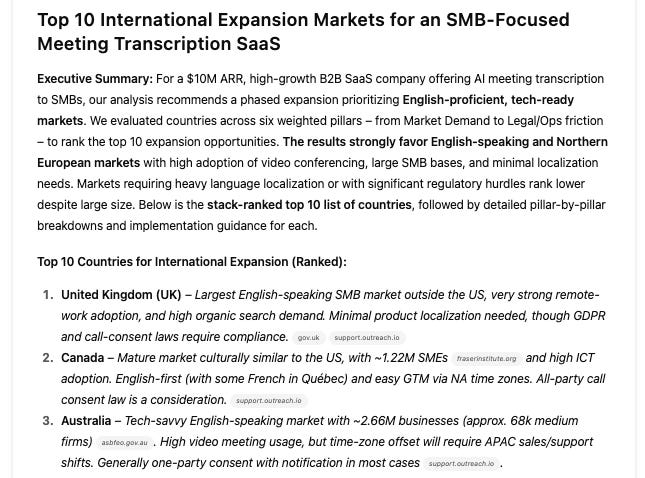
More inspiration on Deep Research
The examples above are just some of the things you can do with Deep Research. The possibilities are literally endless, but covering them all here would make the post way too long.
However, here a few more ideas for you to experiment with:
Using ChatGPT Agent Mode to document how leading companies, or your competitors, are handling flows like booking product demos or onboarding users
Using Perplexity to do a quick pulse check on social media feedback re: your recent launch
Asking ChatGPT Deep Research to compile an exhaustive report on successful marketing stunts and growth hacks that companies similar to yours have used, and then working with a reasoning model (GPT-5 or Claude Opus) to figure out which ones make sense for you and how you should adapt them
Also, if you are using Deep Research (or ChatGPT Agent Mode) for any GTM use cases, I’d love to hear about it in the comments!
Special thanks to Torsten Walbaum for today’s epic guest post! Don’t miss The Operator's Handbook for more deep dives like this one.



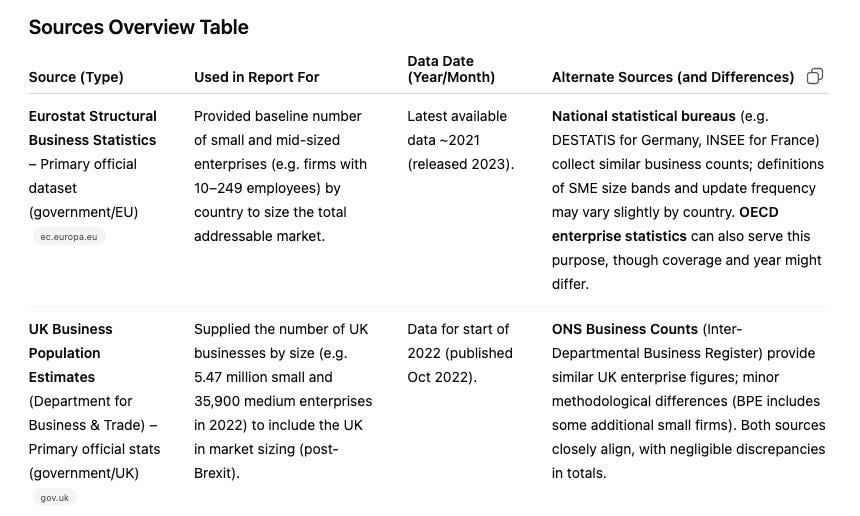


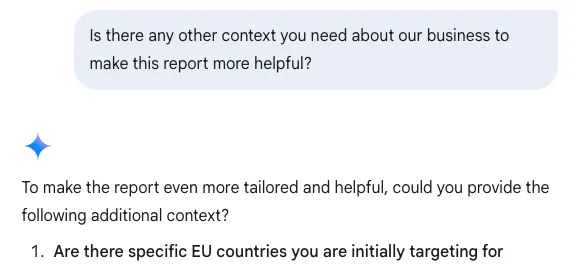
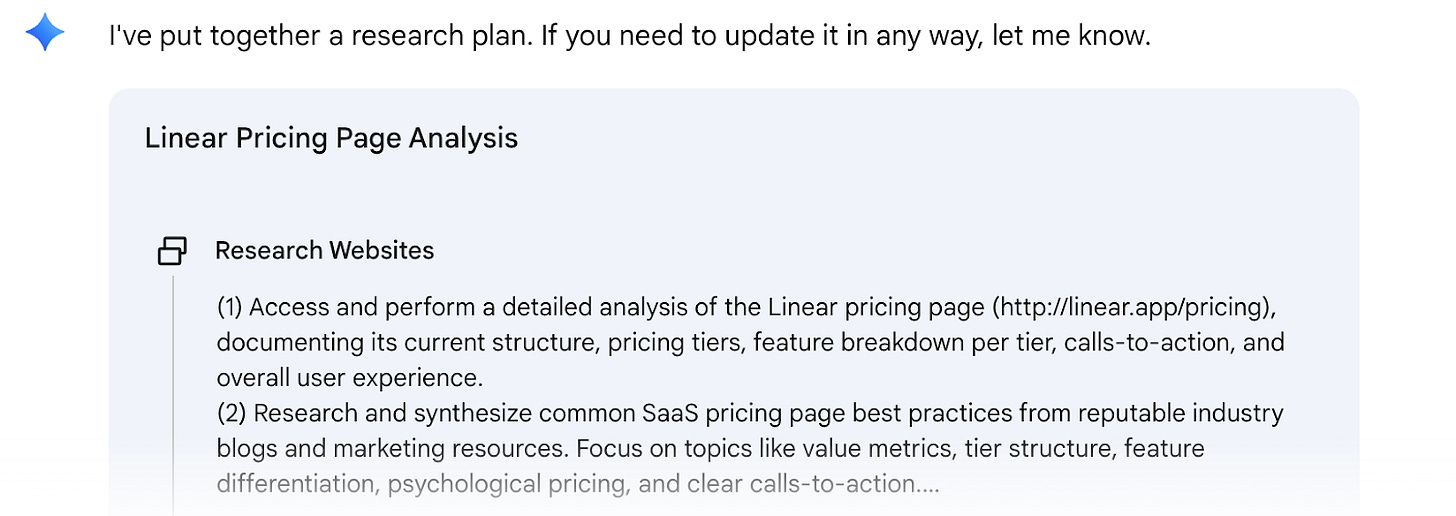



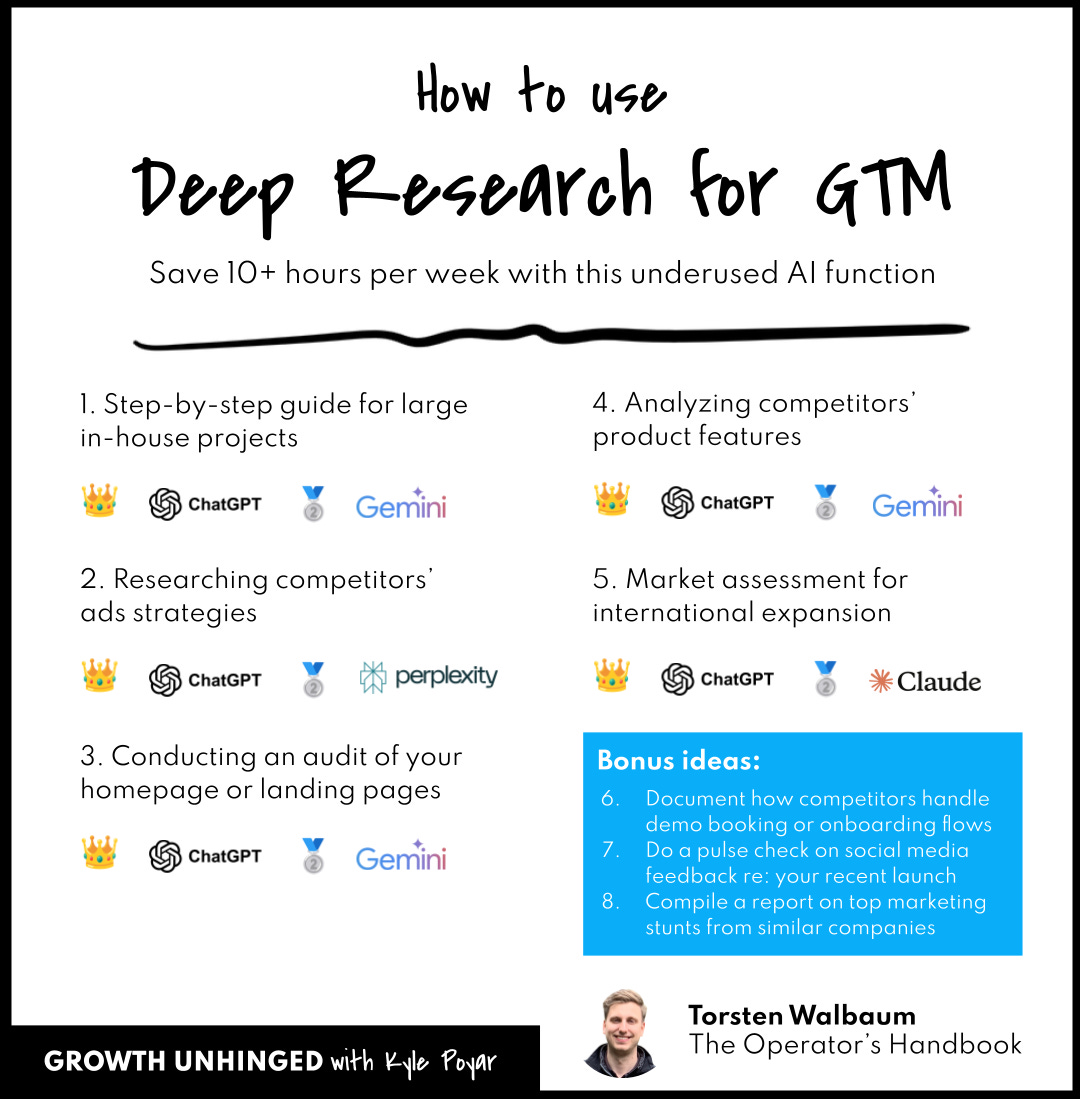





This is, by far, the best article on the topic of GTM i read YTD! thanks a lot. I use Deep Research a lot, e.g. for market research and positioning. But still I got a lot of new ideas from your article!!! Thanks for that!
A very detailed and insightful article on AI & GTM research. Thanks for sharing .